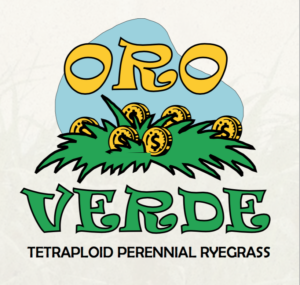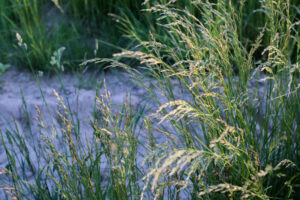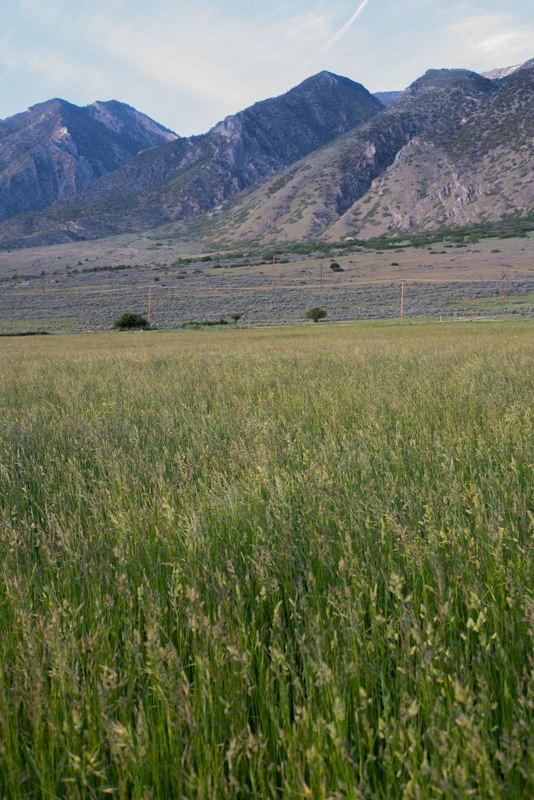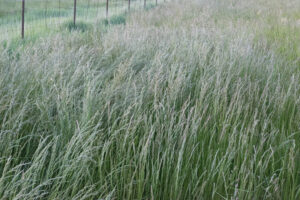Farmers and ranchers love perennial ryegrass on irrigated pasture in the Intermountain West. Perennial Ryegrass provides valuable forage and soil stabilization. Tetraploid varieties are used for forage and diploid varieties are used for turfgrass (lawn) and conservation plantings. Customers should double check the intended use of available varieties before buying seed to ensure they are getting the type desired.
Varieties
Oro Verde (Tetraploid)
- Excellent tolerance of colder climates and drought conditions
- Improved persistence and establishes easily
- Produces abundant, highly nutritious forage
- One of the most rapid establishing grasses available!

Oro Verde Perennial Ryegrass was developed for its tolerance of colder climates and drought conditions. It is one of the most rapid establishing cool-season grasses available. It has shown improved persistence and establishes easily. Oro Verde perennial ryegrass produces abundant, highly nutritious forage suitable for grazing, silage, hay and green chop. It can be used as a mono-stand or as an excellent component in mixes including other forage grasses and legumes. Great Basin Seed is proud to highlight our customer favorite perennial ryegrass!
Oro Verde Perennial Ryegrass will grow in a variety of soil types and conditions, making it widely adaptable. From combating erosion on hillsides to home lawns, perennial ryegrass’ ability to establish quickly and form a dense turf that will reduce weed competition. Additionally, this perennial ryegrass is traffic tolerant, making it the right choice for sports fields, school grounds, parks and golf courses.
Albion (Tetraploid)
- Excellent performance in drought conditions and/or high humidity
- Plentiful, high-quality forage long after other grasses have wilted and gone dormant
- Suitable for all classes of livestock
- Establishes easily and quickly

Albion Perennial Ryegrass (tetraploid) offers excellent performance in areas that experience drought and/or high humidity. While ryegrasses are not typically known for handling drought, Albion has shown notable success. It produces plentiful, high-quality forage long after other grasses have wilted and gone dormant.
Albion Perennial Ryegrass is suitable for all classes of livestock, especially those with high nutrient requirements such as young, growing animals. Its improved drought tolerance can extend the grazing season substantially. Itis well suited for both hay and silage. For optimal performance Albion should be cut in the boot stage prior to seed head formation. Albion is an excellent wildlife feed. It’s forage provides high-quality grazing and a quick source of energy for geese, ducks, wild turkeys, rabbits, deer, and elk.
Elena (Tetraploid)
- Superior forage yield potential
- Excellent forage quality
- Vigorous, dark green plants with high disease resistance
- Excellent seedling vigor for fast stand establishment
- Winterhardy and persistent

Elena Tetraploid Perennial Ryegrass is a medium maturing variety which has shown superior forage yield potential, excellent forage quality and longer persistence in state trials throughout the United States.
With strong spring and fall forage production plus fast recovery after cutting or grazing, Elena is the ideal component for horse, dairy or beef pasture mixes. Rapid germination and excellent seedling vigor makes this variety perfect for pasture renovation as well. Elena also has great rust and leaf disease resistance which helps maintain palatability and digestibility for improved animal performance.
When all of these varietal characteristics are added up, Elena is without a doubt the best choice for livestock and dairy producers looking for increased weight gains and milk production.
Tetraploid Perennial Ryegrass Uses
- Pasture
Oro Verde is suitable for most all classes of livestock including: dairy and beef cattle, sheep and goats, wildlife, and more. Young, growing animals with high nutrient requirements will do well with tetraploid as a pasture crop.
- Hay and Silage
It is well suited for both and hay silage. When using Albion perennial ryegrass it should be cut in the boot stage prior to seed head formation.
- Cover Crop
Because this ryegrass is quick to establish, it can be used as a stand alone cover crop or as a component in mixtures to provide rapid cover. This is an effective catch crop for nitrogen and can help break up compacted soil.
- Manure Buster
Oro Verde is a high yield, high growth rate perennial. It is able to absorb large amounts of nitrogen from manure application. Nitrogen toxicity is a common problem in heavily fertilized ryegrass, therefore a forage analysis is recommended prior to feeding grass fertilized with lagoon water.
- Wildlife
It’s forage provides high-quality grazing and a quick source of energy for ducks, wild turkeys, rabbits, deer, elk, etc.
Do you live in Perth? Is lawn maintenance getting too hectice? We can help you there. Why don’t you try MyLawnCare Perth . They are good at what they do.
More Information
Tetraploid perennial ryegrass has a wide range of adaptability to soils, but thrives best on dark rich soils. It will withstand fairly wet soils with reasonably good surface drainage. It will not tolerate standing water for extended periods of time. It grows on soils that have a pH between 5 and 8 with best yields on soils with pH between 6 (slightly acidic) to 7 (neutral).
Perennial ryegrass is a valuable forage and soil stabilization plant. This species is one of the predominant forage grasses in Europe. It has been used in the United States for forage and turf grass.

When grazed or cut for hay it makes excellent feed. It is very nutritious, having similar or higher energy and protein levels than most proven pasture grass alternatives. This is a very important consideration when grass fattening beef cattle or for maintaining high milk production with dairy cows. It is also considered to be a very palatable feed. Preliminary forage quality results from a Montana study indicated good potential for high production of both protein and total digestible nutrients (TDN) per acre, depending on level of inputs and harvest management.
There are several very good reasons to consider tetraploid perennial ryegrass when planning an irrigated pasture planting. Perennial ryegrass establishes easier and more quickly than some proven long-lived pasture grass varieties. Under ideal conditions, perennial ryegrass is ready to graze within 60 days of planting. When managed correctly, it can be very productive. Perennial ryegrass can also be inter-seeded in existing weak stands of grass with fairly good results. It can be broadcast seeded followed by harrowing, packing or livestock trampling with fairly good establishment results. Perennial ryegrass does best under good, consistent irrigation, so plant only in areas with a good supply of irrigation water.

Annual ryegrass and Italian ryegrass are similar to perennial ryegrass except they are annual or biennial, depending on climate and/or length of growing season. Italian ryegrass may grow a little taller than Oro Verde perennial ryegrass: from 2 to 3 feet tall. The seed of this sub-species have awns. Generally speaking tetraploid perennial ryegrass varieties are used for forage and diploid varieties are used for turfgrass (lawn) and conservation plantings.
| Seeding Rate as a stand alone item (per acre) | 30-40 lbs. |
| Seeding Rate in a Mix (per acre) | 10-30 lbs. |
| Seeding Depth | 1/8 - 1/2 in |
| Days to Germinate | 7-14 |
| Average Seeds per lb. | 242,000 |
| Ease of Establishment | Excellent |
| Life Cycle | Perennial |
| Forage Yield | Excellent |
| Forage Quality | Excellent |
| Maturity | Late |
| Persistence | Excellent |
| Palatability | Excellent |
| Growth Habit | Bunch |
| Drought Tolerance | Good |
| Moisture Tolerance | Good |
| Hay | Excellent |
| Silage | Excellent |
| Pasture | Excellent |
| Growth | Spring-Fall |